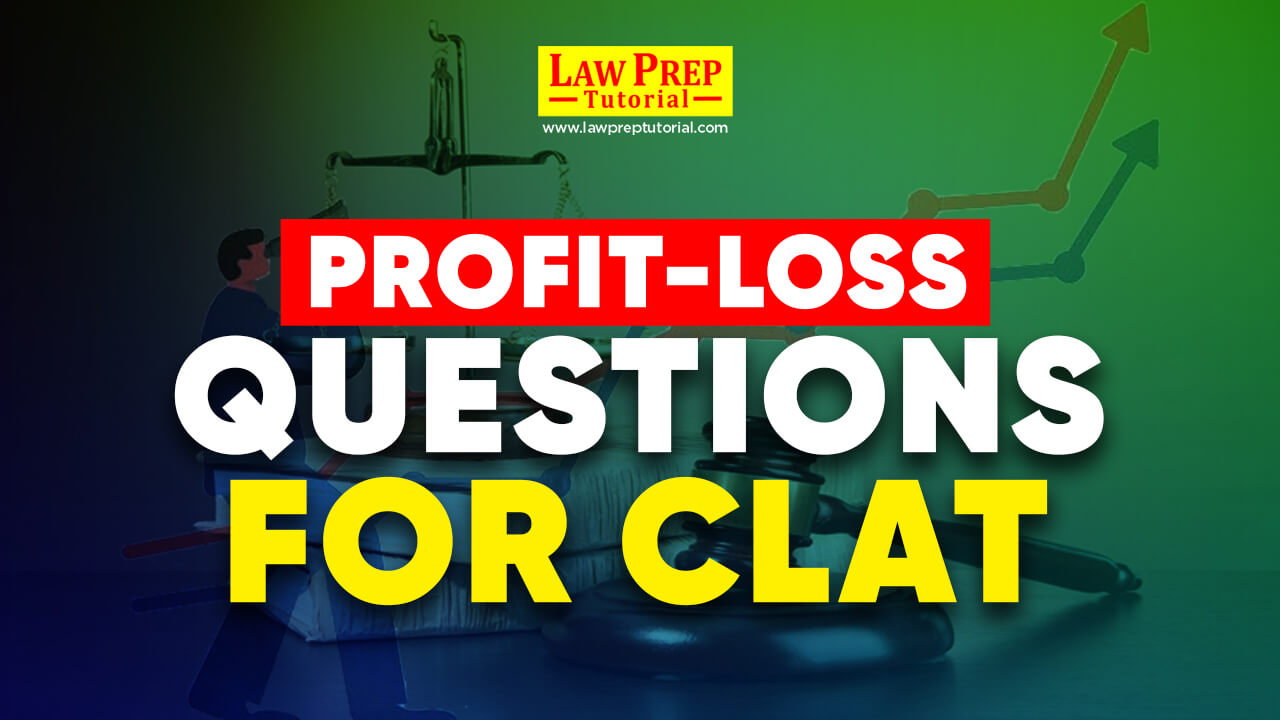Profit and loss questions are an essential part of the CLAT quantitative techniques. These questions test your ability to calculate and analyze financial problems, making them crucial for your overall score.
To excel, practice regularly with a variety of problems, including those involving percentages and discounts. Using CLAT mock tests and reviewing previous year’s papers significantly improve your speed and accuracy.
These resources provide insights into the CLAT exam pattern and help you familiarize yourself with different types of profit-loss questions, ensuring better preparation and confidence during the actual exam.
Upcoming CLAT Exams:
Importance of Quantitative Techniques in CLAT
The quantitative techniques section of CLAT plays a crucial role in evaluating a candidate’s mathematical and analytical skills. This section includes questions on various topics, including percentages, which test a candidate’s ability to interpret data, solve problems efficiently, and make accurate calculations.
A strong performance in this section can significantly boost the overall score, as it contains straightforward questions that, when understood and practiced well, can be solved quickly and correctly.
| Subjects | No. of Questions | Weightage |
| English Language | 22-26 | 20% |
| Current Affairs, including General Knowledge | 28-32 | 25% |
| Legal Reasoning | 28-32 | 25% |
| Logical Reasoning | 22-26 | 20% |
| Quantitative Techniques | 10-14 | 10% |
Profit and Loss Questions for Practice
Following are the Profit Loss Questions for CLAT:
Passage 1:
There are three persons A, B and C who each invested in two different schemeS1 and S2. A in invested Rs 80,000 for 2 yr in scheme S1 and 30,000 for 4 years in scheme S2. B invested Rs 30,000 for 3 year in S1and he did not invest in scheme B. B also obtained a profit of 10,000 by selling his car. C invested Rs 50000 for 5years in scheme S1 and 10000 for 3 year in scheme S2. Total profit obtained from scheme S1 is 2 lakh and scheme S2 is 90,000.
Q1. What is the ratio of total profit obtained by B and profit obtained by C from scheme S1
(a) 23 : 47 (b) 54 : 47
(c) 36 : 43 (d) 23 : 50
Q2. Profit obtained by A from scheme S1 is what percent of profit obtained by C from scheme S2.
(a) 346 (b) 347 %
(c) 356 % (d) 355
Q3. If sum of company of A in both schemes and totalprofit obtained by A from both scheme is invested at compound interest at the rate of 20% p.a. then find the total compound interest obtained in 2 yr.
(a) 108240 (b) 104206
(c) 105208 (d) 109280
Q4. What is the average of profit attained by A from scheme S1 and profit of C obtained from scheme S2.
(a) 41000 (b) 42000
(c) 44000 (d) 55000
Q5. If A had invested his sum at Simple Interest for 3 yr at the rate of R% p.a. instead in scheme S1 and B has invested his sum at compound Interest at (R + 5%)p.a. for 1 year and difference in interest obtained is 30,000 then find value of R%.
(a) 10% (b) 9%
(c) 15% (d) 18%
Free CLAT Study Material for You:
| CLAT Previous Year Papers PDF | CLAT Sample Papers |
| CLAT Syllabus PDF | Free CLAT Coaching |
| CLAT Current Affairs | CLAT Topper Interviews |
| CLAT Videos | CLAT Mock Tests |
Passage 2:
Kingfisher group of company acquired four team of IPL viz. Mumbai Rock, Delhi Rock, Patna Rock and Pune Rock. They invest some money (expenses) and earned revenue by selling its tickets. After completion of league the results (expenses, revenue, profit and loss) of the teams for the year 2015 were summarized. Chairman of Kingfisher group found that the profit of Patna Rock and Pune Rock were same, the revenue earned by sell of Patna Rock tickets were the same as those of Delhi Rock. Profits of Mumbai Rock were 10.75% of revenue earned by its tickets sales, whereas the profits of Delhi Rock were 20% of revenue earned by its tickets sales. While the total expenses of Patna Rock were 2.5 times its profits, revenue earned by sells the ticket of Pune Rock were 1.5 times of its profits. The total expenses of Patna Rock were 12 million and of Mumbai Rock were 10% less than those of Patna Rock. Profit is defined as the difference between sales and total expenses.
Q6. Profit of Pune Rock was what percent of its sales?
(a) 66.67% (b) 61.67%
(c) 59.67% (d) 52.67%
Q7. Profit of all four team together which was acquired by Kingfisher group was what percent of its sales?
(a) 28.96% (b) 26.96%
(c) 22.87% (d) 21.81%
Q8. If all four teams Mumbai Rock, Delhi Rock, Patna Rock and Pune Rock donate 20%,40%,10% and 50% of its profit respectively to a school of basic education for slum children, total donated money is what percentage the profit of all companies together?
(a) 35.41% (b) 37.41%
(c) 31.41% (d) 39.41%
Q9. Which team has highest efficiency? Efficiency = (Profit / Sale) × 100
(a) Mumbai rock (b) Delhi rock
(c) Patna rock (d) Pune rock
Q10. Find the ratio of average sells to average profit of all teams together?
(a) 11 : 13 : 4.56 (b) 17 : 15 : 8.93
(c) 13.22 : 3.56 (d) 13 : 21 : 3.59
Must Know for Every CLAT Aspirant:
| CLAT Eligibility Criteria | CLAT Exam Pattern |
| CLAT Age Limit | CLAT Marking Scheme |
| How to Prepare for CLAT? | CLAT Preparation Books |
Passage 3:
Gaurav, a sweet seller, bought some quantity of three types of sweets Rasgulla, Rasmalai and Kalakand in ratio of 6 : 10 : 9. Kalakand costed him a total of Rs. 18,900 at rate of 420 per kg. By selling Kalakand at a discount of 5% he earned a profit of 13 %.On Rasmalai (which was marked Rs. 500 per kg) he earned Rs. 5 less profit per kg as compared to that on Kalakand by selling Rasmalai at 10% discount. Gaurav spent a total of Rs. 46,400 on buying these sweets, while he earned a total profit of Rs. 5875 on selling all bought sweets. Rasgullas were marked 40% above cost price per kg.
Q11. Find the average cost price of three sweets together?
(a) Rs. 365.8 (b) Rs. 371.2
(c) Rs. 420.5 (d) Rs. 325.2
Q12. If Gaurav gave an extra discount of 20% on Kalakand, then his gain% or loss% was:
(a) 9 % profit (b) 8 % loss
(c) 10 % loss (d) 9 % loss
Q13. Find the total quantity of sweets bought by Gaurav?
(a) 135 kg (b) 126 kg
(c) 125 kg (d) 120 kg
Q14. If 10kg of Rasmalai was wasted away due to some reason. Find profit% or loss% by selling the remaining Rasmalai as per given condition.
(a) 10% loss (b) 10% gain
(c) 12% loss (d) 15% loss
Q15. Cost price per kg of Kalakand was what percent less than marked price per kg of Kalakand?
(a) 18% (b) 16%
(c) 15% (d) 12%
Basic Concepts of Profit and Loss Questions
Cost Price (CP): The amount of money spent to purchase or produce a product. It is the initial price of the item before any sale.
Selling Price (SP): The amount of money for which the product is sold to the customer. It is the final price at which the item is sold.
Profit: When the selling price (SP) is greater than the cost price (CP), the difference is called profit.
Formula:
Profit = SP – CP
Loss: When the selling price (SP) is less than the cost price (CP), the difference is called loss.
Formula:
Loss = CP – SP
Best Books for CLAT Quantitative Techniques
| Book Name | Author Name |
| Quantitative Aptitude for Competitive Examinations (English) | RS Aggarwal |
| Data Interpretation | BSC Publications |
| Magical Book on Quicker Maths | M Tyra |
| Quantitative Aptitude for Competitive Examinations | Pearson’s |
View CLAT Preparation Books for All Subjects!
CLAT Previous Year Papers
To help you prepare effectively and be ready for the CLAT exam date 2025, we have shared the collection of CLAT previous year papers. These papers provide valuable insights into the exam format and types of questions asked, helping you refine your study strategy.
Checkout CLAT previous Year papers of 18 years.
Important CLAT Questions for Practice:
| CLAT Legal Reasoning Questions | CLAT Logical Reasoning Questions |
| CLAT English Questions | CLAT GK Questions |
Join Online CLAT Crash Course!
If you haven’t been part of any coaching program yet, consider joining the online CLAT Crash Course to enhance your preparation.
The 3-month crash course by Law Prep Tutorial is designed to give you the boost needed for success in the 2025 exam. This course covers all essential topics, provides strategic study plans, and offers intensive practice sessions.
With expert guidance and comprehensive resources, you can maximize your chances of achieving a high score.
Important Resources After CLAT Exam:
Law Colleges Information Related to CLAT:



